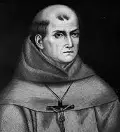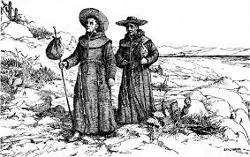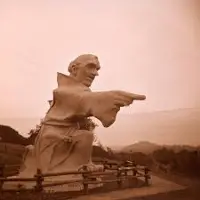Father Junipero Serra: California's Leading Missionary
Junipero Serra was the driving force behind the early establishments of Catholic missions in what is now California in the late 18th Century. 
He was born on Nov. 24, 1713, in the village of Petra on Mallorca, an island owned by Spain. In his earliest years, he worked on his parents' farm. An intelligent child, he excelled at a local school run by the Franciscan Order, learning reading, writing, Latin, and mathematics. He took a special liking to religious studies and religious songs, particularly Gregorian chant. At 16, he gained entrance to a Franciscan school in the city of Palma. He soon took holy orders (replacing his birth name, Miguel, with Junipero, after a famous former Franciscan) and, by age 24, was a professor of theology. He studied even harder, mastering cosmology and logic and metaphysics, and furthered that appointment in 1742 by gaining a doctoral degree in theology from the well-known Lullian University and then becoming a professor there the following year. His specialty was philosophy. Serra was a gifted speaker who had a magnetic personality and a zeal for living and for sharing his love for religious teachings. He also wanted to see more of the world. In 1749, he signed on with a voyage of 20 Franciscan friars traveling to the Spanish colonies in the Americas. He landed at Vera Cruz and, rather than making the journey on horseback along with the others who had sailed with him, insisted on walking the 250 miles through tropical forests, arid plains, and high mountains to his destination, a mission in Mexico City. A leg injury sustained along the way did not slow him down but did cause him grief for the rest of his life. Spain had established the College of San Fernando in Mexico City, and Serra worked there for a time. He also did missionary work with the nearby Native Americans, setting out to spread the word of Christianity as wide as he could. Another role he had was working with the Spanish Inquisition, seeking out and punishing those who refused to denounce beliefs that Spanish religious authorities considered heretical. (The beliefs of many native peoples met this condition.) The governor of New Spain in 1768 sent Serra to establish a series of missions in what is now California. He did so with gusto (sailing this time the 200 miles from San Blas up the California coast), founding the first mission, in what is now San Diego, in 1769 and founding eight other missions up and down the coast, including one in what is now Carmel that he took for his headquarters. The other missions he founded were these, going north from San Diego:
Seeing the need for more men and funds, Serra convinced the governor to send him more of both. Missions were commonly accompanied by towns and forts, populated with settlers and soldiers, and the Spanish population in California grew. 
Like others from Spain, Serra believed that it was his mission to educate Native Americans whom he saw as "backward" in the ways of civilization and of his religion, Christianity. He was strict but fair. He ruled with a firm hand, allowing corporal punishment for those who disobeyed his rules or instructions. (This was a departure from others of his order and made him somewhat of a controversial figure.) Serra drove himself as hard as he drew his followers. Stories abound of his self-inflicted pain, including wearing a heavy shirt inside of which were sharp wires that poked his skin. He was also known to engage in self-flagellation, whipping himself as part of a scheme of mortification that was not uncommon with devout religious figures of the time. He was also known to perform such acts while giving a sermon. 
He was the head of the Franciscan Order and of the mission system in California until his death from tuberculosis, in 1784, at Mission San Carlos. By this time, the missions that he had founded had baptized more than 6,500 Native Americans and converted more than 4,000 to Christianity. Father Junipero Serra has a complicated legacy. He is known for his zeal and for his self-affliction and for being the driving force behind the establishment of the mission system in its early days. He is known for his strictness, for his strong encouragement of others to undertake backbreaking work, and for his |
|
Social Studies for Kids
copyright 2002–2024
David White



 Mission San Buenaventura, founded in 1782 near what is now Ventura
Mission San Buenaventura, founded in 1782 near what is now Ventura
 allowance of physical punishment for those who disobeyed him. He is also known as the "Father of California Wine," for the Mission grape that he planted at his first mission, San Diego, in 1779, at what became the California area's first sustained vineyard. The chapel at Mission San Juan Capistrano, which he helped build in 1782, is regarded by many as the oldest building still standing in what is now California. His name is part of the names of streets, schools, neighborhoods, and geographical features throughout California. He has appeared on postage stamps in both Spain and the United States. A statue of him is in the U.S. Capitol's National Statuary Hall Collection. A granite statue of him pointing, as if directing his followers, stands on a hillside above a freeway near Hillsborough. Other well-known statues of him stand in front of Ventura City Hall and in San Francisco's Golden Gate Park. His remains now rest at the Carmel mission.
allowance of physical punishment for those who disobeyed him. He is also known as the "Father of California Wine," for the Mission grape that he planted at his first mission, San Diego, in 1779, at what became the California area's first sustained vineyard. The chapel at Mission San Juan Capistrano, which he helped build in 1782, is regarded by many as the oldest building still standing in what is now California. His name is part of the names of streets, schools, neighborhoods, and geographical features throughout California. He has appeared on postage stamps in both Spain and the United States. A statue of him is in the U.S. Capitol's National Statuary Hall Collection. A granite statue of him pointing, as if directing his followers, stands on a hillside above a freeway near Hillsborough. Other well-known statues of him stand in front of Ventura City Hall and in San Francisco's Golden Gate Park. His remains now rest at the Carmel mission.


